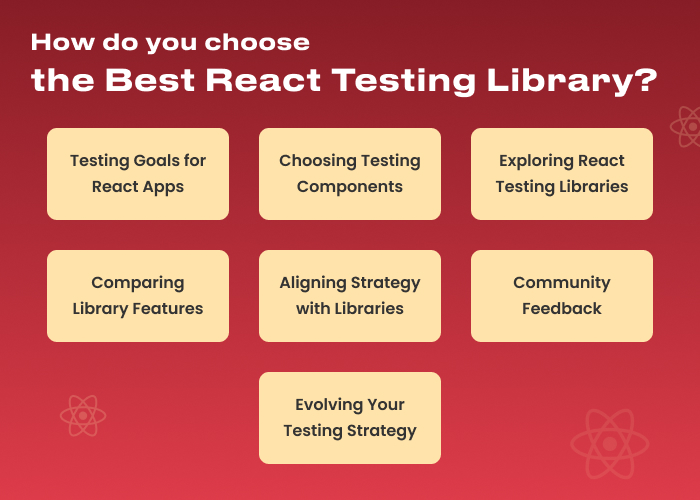How do you choose the best React testing library?

The needs of your project, the experience of the QA team, objectives, and personal preferences all play a role in selecting the best React testing library. Here is a step-by-step method to assist you in making decisions:
- Set goals and objectives for your testing first. Choose the components, that you wish to test in your React application.
- Examine the particular needs of your project, taking into account its scope, technology stack, and scale. Furthermore, take into account aspects like scalability, and interoperability with other tools and libraries in your project.
- Examine the different React testing libraries that the community has to offer. Moreover, think of more recent options that could provide special features or benefits, as well as well-known options like Cypress and Jest.
- Evaluate each testing library’s features and capabilities with regard to your project’s needs and testing objectives. Consider elements like ease of use of the API, the caliber of the documentation, community support, and compatibility with other testing tools.
- Furthermore, choose a testing library that aligns with your preferred approach and provides adequate support for your testing strategy.
- Seek feedback from peers, colleagues, and online communities with React testing experience.
- Remember that choosing a testing library is not a one-time decision. Thus, as your project evolves and your testing needs change, be open to revisiting your library choice and adapting your testing strategy accordingly.
Best testing library for React
Below is the list of the top 5 testing libraries for React.
Jest React testing library
The most widely used testing library for React created and administered by Facebook is called Jest. Uber and other companies have embraced and used it to test React components.
The React Community strongly advises using Jest as their preferred React testing framework. It has a test runner of its own.
The major benefit of Jest testing is that it is open-source and supports parallel testing. Furthermore, it offers live snapshots and is compatible with Vuejs, AngluarJs, etc.
Jasmine
Testing many types of JavaScript apps may be done with Jasmine, an excellent free BDD testing framework. It also has its own test runner. Furthermore, it looks at how responsive and readable the user interface is on a variety of screen sizes.
Mostly, this React testing library is used together with Enzyme and Babel. Testers use Jasmine when they need to test large projects. The major benefit is that it is easy to learn and user-friendly.
Karma
Karma is a Node.js-based JavaScript test runner. It develops an HTML file for the test runner and creates an HTTP server.
It was designed to make the feedback loop between creating code and obtaining data from tests as simple as possible. It enables one to run JavaScript code across several actual browsers.
Because of its connection with well-known continuous integration tools like Jenkins and Travis, test-driven development is made quick, enjoyable, and simple.
Enzyme
Enzyme is a React testing library intended to make it easier for developers to test the React components. It is among the most popular frameworks that Airbnb has created.
To test the React component, it is simply integrated with different frameworks like Jest React testing library, Mocha, etc. The enzyme is utilized for object access, component rendering, element discovery, element interaction, and event simulation.
Cypress IO
Writing tests without the need for extra testing frameworks is made possible by Cypress, an incredibly quick end-to-end React testing library. It makes it possible to conduct tests using command lines or actual browsers.
In addition to evaluating the code in an actual browser, browser development tools may be used simultaneously. It has a control panel that allows you total control over the state of every test.
Conclusion
Selecting the appropriate React testing library is essential to guaranteeing the dependability and steadiness of your apps. There isn’t a single best alternative for every situation. Thus, taking into account variables including project requirements, community support, and individual preferences may help you identify the best choice.
Whichever library you choose—the feature-rich Jest, the straightforward Jasmine, the adaptable Karma, the user-friendly Enzyme, or the smooth end-to-end testing of Cypress—each one has certain advantages that can improve your testing.
To keep ahead in the rapidly expanding field of React development, never stop trying new things, getting feedback, and refining your testing approach.
FAQs
What makes Jest the preferred choice for React testing?
Jest is favored for its comprehensive features, including parallel testing, live snapshots, and compatibility with various frameworks. Its association with Facebook and widespread adoption by companies like Uber add to its credibility.
How does Enzyme simplify React component testing?
Enzyme, developed by Airbnb, streamlines React component testing by providing intuitive methods for object access, component rendering, element discovery, interaction, and event simulation. Its integration with Jest and other frameworks enhances its usability.
Why is Cypress IO known for its speed in end-to-end testing?
Cypress IO stands out for its rapid end-to-end testing capabilities, allowing tests to be conducted using either command lines or actual browsers. Its simultaneous evaluation of code in real browsers, coupled with browser development tools, ensures efficient and thorough testing.
What sets Karma apart from other test runners?
Karma distinguishes itself with its seamless integration with popular continuous integration tools like Jenkins and Travis, making test-driven development quick, enjoyable, and straightforward. It simplifies the feedback loop between code creation and test results.
How does Jasmine contribute to Behavior-Driven Development (BDD) in React testing?
Jasmine excels in BDD testing for various JavaScript applications, including React, by offering an intuitive syntax and its own test runner. It emphasizes readability and responsiveness across different screen sizes, making it suitable for testing large projects.
Shivangi is a passionate Copywriter at Alian Software with expertise in technical copywriting. She shares information that is easy to understand regarding business, technology, and trends.